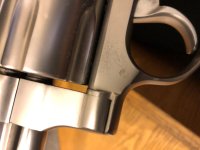Sharpshooter82
Member
I have a very nice custom 686 which has been bead blasted. However there is a small scratch on the frame. I'm trying to find a way to remove it without having to re-bead blasted the gun.
This fella did youtube video using 80 grit sand paper ; by placing the 80 grit sand paper on top of scratch and tapping it with a hammer.
Would this work ?
[ame]https://www.youtube.com/watch?v=BmV9el-ogKQ[/ame]
bead blasting repair starts at 3:25
cheers
This fella did youtube video using 80 grit sand paper ; by placing the 80 grit sand paper on top of scratch and tapping it with a hammer.
Would this work ?
[ame]https://www.youtube.com/watch?v=BmV9el-ogKQ[/ame]
bead blasting repair starts at 3:25
cheers

